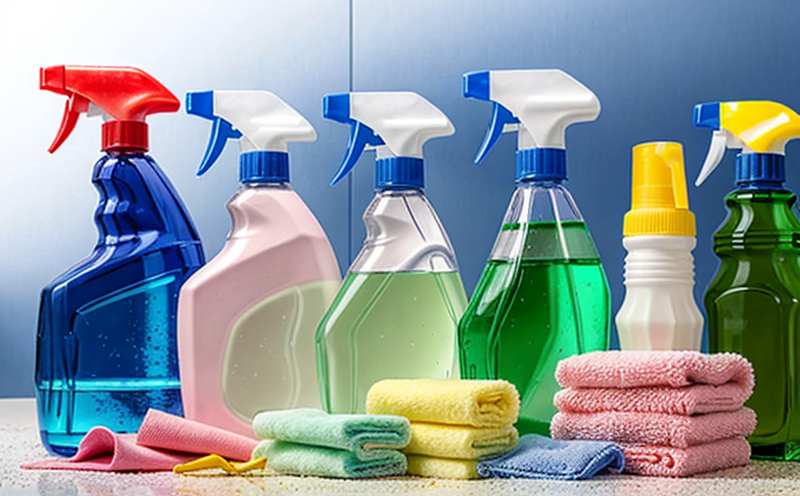Skin Irritation Testing of Cleaning Agents
In the realm of consumer products and product safety testing, skin irritation testing plays a critical role in ensuring the safety and well-being of consumers. This service is particularly important for cleaning agents, which are commonly used in households and workplaces alike. Skin irritation can have serious health implications if not properly addressed, making rigorous testing essential.
The primary objective of skin irritation testing is to assess the potential for a substance to cause localized damage or inflammation on human skin. This service involves various stages, each designed to simulate real-world conditions under which the cleaning agent may come into contact with the skin. The testing process can be broadly categorized into several key components:
- Preparation of Specimens: Samples of the cleaning agent are prepared according to ISO 10993-11, which outlines methods for performing skin irritation tests. The specimens must be representative and stable over time.
- Contact with Human Skin: The test involves contacting human cadaver skin or synthetic skin models with the sample under controlled conditions for a specified duration (typically 4 hours). This mimics the actual use scenario where users might come into contact with the cleaning agent.
- Observation Period: Following exposure, the area is observed for signs of irritation such as erythema (redness), edema (swelling), and other visible changes. The test is conducted under ISO 10993-11 guidelines to ensure consistency.
- Evaluation Criteria: The results are evaluated based on standardized criteria, which can include subjective assessments by trained observers as well as more quantitative measures like the Erythema Index (EI).
The importance of this service cannot be overstated. It ensures that cleaning agents meet regulatory requirements and industry standards, thereby protecting consumers from potential harm. Additionally, it helps manufacturers develop safer products by identifying any issues early in the process.
Industry Applications
The skin irritation testing of cleaning agents is applicable across various sectors where hygiene and cleanliness are paramount:
- Household Products: Cleaning agents used in homes, such as detergents, disinfectants, and hand soaps.
- Commercial Settings: Cleaning products used in offices, restaurants, and public restrooms.
- Industrial Applications: Chemicals and solutions used for industrial cleaning processes.
In all these applications, ensuring the safety of the product is crucial. Skin irritation testing helps manufacturers comply with strict regulations such as REACH in Europe or TSCA in the United States. It also ensures that products perform effectively while maintaining a high level of safety for end-users.
The results of skin irritation tests are critical inputs into the overall risk assessment process, helping companies to make informed decisions about product formulations and label claims. Compliance with these standards not only protects consumers but also enhances brand reputation and market competitiveness.
Environmental and Sustainability Contributions
In addition to ensuring consumer safety, skin irritation testing of cleaning agents contributes positively to environmental sustainability:
- Reduction in Waste: By identifying irritants early in the development process, manufacturers can refine formulas and reduce unnecessary product reformulations, ultimately minimizing waste.
- Innovation for Safer Alternatives: The testing process encourages the exploration of safer ingredients and formulations that minimize harm to both humans and the environment.
- Regulatory Compliance: Meeting stringent testing standards helps companies avoid fines and penalties, which in turn supports long-term sustainability initiatives.
The use of environmentally friendly cleaning agents is gaining traction globally. Skin irritation testing plays a vital role in this transition by ensuring that these products are safe for human contact while also being biodegradable and non-toxic to aquatic life.
Competitive Advantage and Market Impact
In today’s competitive market, skin irritation testing of cleaning agents offers significant advantages:
- Enhanced Consumer Trust: Products that meet rigorous safety standards build trust with consumers, leading to increased brand loyalty.
- Regulatory Compliance: Compliance with international standards ensures products can be marketed globally without encountering regulatory barriers.
- Innovation and Differentiation: Companies that invest in advanced testing methods are better positioned to innovate and differentiate their offerings, gaining a competitive edge.
The global market for cleaning agents is expected to grow as more countries adopt stringent hygiene standards. Skin irritation testing not only ensures compliance but also helps companies stay ahead of the curve by identifying potential issues early on. This proactive approach can lead to significant cost savings and improved product performance, ultimately contributing to long-term business success.





